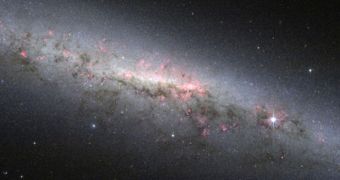Astronomers working with the NASA/ESA Hubble Space Telescope captured a breathtaking view of the galaxy NGC 7090, which lies edge-on as seen from Earth. The photo reveals its central bulge, as well as some of its largest gas and dust concentrations (darker areas).
The intricate pattern of pinkish red regions reveals areas where new stars are formed at a fast pace. These so-called stellar nurseries are filled with hydrogen gas, which collapses under its own weight and catches fire, leading to the formation of protostars.
Due to the galaxy's orientation as seen from our vantage point, its spiral structure is not visible. But astronomers say that the object is very similar to the Milky Way in terms of structure and size.
This object was first observed on October 4, 1834, by famous astronomer John Herschel. It lies around 30 million light-years from Earth, in the southern constellation of Indus.

 14 DAY TRIAL //
14 DAY TRIAL //